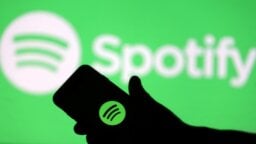In making the argument for higher subscription prices at music streaming services, recording company execs have often compared the stagnant prices at Spotify and others with the (relatively) rapidly rising prices at TV and movie DSPs.
During Warner Music Group’s latest earnings call on Tuesday (August 8), CEO Robert Kyncl pointed out that in 2011, when Spotify launched in the US, a monthly subscription to Netflix cost $7.99. Today, that subscription costs $15.49.
If the streaming services that – until recently – charged $9.99 per month had raised their prices proportionally to Netflix, they would cost $19.37 today.
“Now, let me be clear, I am not suggesting that we go to $19 today,” Kyncl said. “What I’m pointing out is… the elasticity that is there.”
Kyncl called the recent price hikes at music DSPs “an encouraging start” and noted that “there’s no evidence that the [streaming] services are experiencing elevated levels of customer churn.”
In other words, Kyncl’s implication was that DSPs like Spotify, Apple Music and YouTube Music can keep raising their prices, beyond the $10.99 level that is now the industry standard in the US, without damaging their business.
Those making the comparison between music streaming services and film/TV streaming services will likely be encouraged to hear about the latest move from Disney, which announced alongside its earnings report Wednesday (August 9) that it’s raising prices, once again, on its Disney+ streaming service.
The ad-free version of Disney+ in the US will be going up to $13.99 per month, from its current $10.99, an increase of more than 27%. That’s a substantially larger price hike than the one-dollar increase to individual plans that have been instituted by the music streaming services.
Disney will also be hiking the monthly cost of the ad-free version of its Hulu TV streaming service, from $14.99 at present to $17.99. And its ad-supported package of Disney+, Hulu and sports service ESPN will be rising from $12.99 to $14.99.
That’s certain to put more weight behind the music industry’s argument that music DSPs are leaving money on the table by undervaluing their services.
However, it’s worth noting that film and TV streaming services are working in a significantly different environment than music streaming services, and that may be creating different incentives when it comes to pricing.
The market dynamics are somewhat different for music streaming services than for film/TV services; while the latter compete with each other by offering exclusive content not available on other services, music streaming services can offer virtually the entire world of music to their subscribers. However, that means there is little to differentiate their core value propositions.
In building their subscriber bases, film/TV DSPs like Netflix, Disney+, Max and others have made massive outlays on content. Disney is reported to have spent $33 billion on content in 2022 alone, while Netflix is estimated to have spent around $17 billion.
That’s a stark contrast to music DSPs, which license already existing content from rights holders.
And Disney+ has been losing money. The company’s direct-to-consumer division clocked an operating loss of $512 million in fiscal Q3. That’s a significant improvement from the same quarter a year earlier, when Disney posted a $1.06 billion loss in its direct-to-consumer division.
The improvement has been driven by aggressive cost-cutting measures, including a company-wide headcount reduction of 7,000 earlier this year.
But even the improved number in the latest quarter is much larger than Spotify’s net loss of €302 million for the same three-month period.
And while the price hikes at music DSPs have – at least so far – not impacted subscriber numbers, the same may not be true for the film/TV streaming services.
At Disney+, declines in subscriber numbers have coincided with increasing prices.
The service launched in the US in 2019 with a monthly subscription price of $6.99. The price went up to $7.99 in March of 2021, then again to $10.99 in December of 2022. The lower-priced ad-supported tier was introduced at this time as well.
The service has seen declining subscription numbers for the past four quarters, with total global subscriptions dropping from a peak of 164.2 million in fiscal Q4 2022, to 146.7 million in fiscal Q3 2022.
In the latest quarter, US and Canada subscriptions dropped by 300,000, to 46.0 million, reflecting a slowdown in the rate of decline from earlier quarters.
The service saw a dramatic drop in subscribers to its Disney+ Hotstar service in India in the latest quarter, with subscriptions dropping from 52.9 million paid users to 40.4 million paid users – although that is largely attributable to Hotstar losing the rights to stream the Indian Premier League cricket tournament. (And in any case, Hotstar’s low subscription prices mean the service accounts for very little of Disney’s revenue.)
Netflix, too, has struggled with subscriber numbers amid its ongoing price hikes. After growing steadily for more than a decade, Netflix’s registered its first-ever subscriber declines in the first two quarters of 2022, dropping from 221.84 million worldwide to 220.67 million.
However, whether the subscription declines are related to the price hikes is debatable – the declines also coincided with the period when Covid-19 pandemic restrictions were being lifted, and viewers were spending less time at home.
“There’s no evidence that the [streaming] services are experiencing elevated levels of customer churn.”
Robert Kyncl, Warner Music Group
For Netflix, the key to turning around its declining subscriber numbers was two-pronged: The launch of a new, lower-priced ad-supported subscription plan, and a crackdown on password sharing.
While the impact of the ad-supported tier hasn’t yet been seen in Netflix’s results, the password crackdown – which began in the first half of this year with markets in Latin America, Canada, New Zealand, Portugal, Spain and eventually the US – resulted in a boost to subscriber numbers of 5.9 million in Q2 2023.
Netflix is now predicting another boost of 6 million subscribers in Q3 of this year, and plans to expand the password crackdown to virtually all of its markets.
Following that success, Disney CEO Bob Iger told analysts on the company’s earnings call Wednesday (August 9) that Disney+, Hulu and ESPN will be launching their own password-sharing crackdowns.
Iger said the company would offer details later this year on new account-sharing policies, and plans to roll out tactics to mitigate password-sharing in 2024.
“We already have the technical capability to monitor much of this,” Iger said. “I’m not going to give a specific number, except to say that it is significant.”
“Music is highly undervalued and… platforms like us have more pricing power than initially anticipated.”
Jeronimo Folgueira, Deezer
There’s an argument to be made that Spotify and other music streaming services could also benefit from such a crackdown. In a recent analysis, MBW estimated that Spotify could gain 14 million paid subscribers from a password-sharing crackdown.
This is based on estimates from Evercore ISI’s head of internet research, Mark Mahaney, who said that around 100 million of Netflix’s accounts are sharing passwords, and he expects around one-third of those to eventually sign up for a new account.
Whether or not happens, the odds of recurring price hikes at music DSPs are rising – as evidenced by recent comments from Deezer CEO Jeronimo Folgueira.
The France-headquartered music streaming service’s price hike in early 2002 had “pretty much no impact on churn, which has clearly demonstrated that music is highly undervalued and that platforms like us have more pricing power than initially anticipated,” Folgueira said on the company’s earnings call on August 3.
That, combined with the recent price hikes at Spotify and others, “gives us the opportunity to review pricing again in the near future,” he added.Music Business Worldwide




